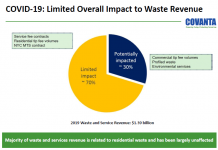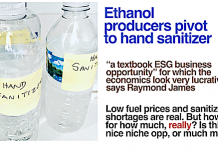Last Friday (Feb. 2), the Globe & Mail’s business section (the G&M is Canada’s top national newspaper) ran an interesting piece by a senior business writer on cellulosic ethanol. I wish there was a way to view this article for free, but, unfortunately, the G&M charges for access to certain of its articles, and this is one of them. The gist of the argument is as follows: (a) forget corn-based ethanol, the future lies with cellulosic (yyaawwnn…); (b) deep down inside, Bush knows this; (c) to make cellulosic ethanol competitive, you need super-enzymes that speed up the process of breaking down the cellulose and transforming the biomass into a liquid fuel; (d) because of 2 companies’ super-enzymes, the cost of producing cellulosic ethanol will go from about $2.25 a gallon today to $1.07 by 2011; (e) it will be possible, then, to convert about 1 billion tons of biomass into liquid fuel annually, which will equate, in energy terms, to about 3.5 billion barrels of oil, and this without any adverse impact on the food supply. Sounds interesting? It’s because it is. Those of you who visit this blog often know that I belong to the camp of those who maintain that corn-based ethanol is nothing but a distraction. The 2 companies identified in the article as holding the enzymatic key to unlocking the potential of cellulosic ethanol are: Novozymes, a subsidiary of Novozymes AS [OTC:NVZMF.PK]; and Genencor, a subsidiary of Danisco AS [OTC:DNSOF.PK]. Although both subsidiaries are based in California, both parent companies are Danish and their primary listings are on the Copenhagen exchange (Danisco AS [Copenhagen:DCO.CO] and Novozymes AS [Copenhagen:NZYM.CO]). The Pink Sheets listings are less than ideal… 
 Novozymes and Genencor have, respectively, a 40% and a 20% share of the global market for enzymes used in ethanol production. The article concludes with this prediction by Michael Pacheco, director of the National Bioenergy Center in Golden, Colorado: production of cellulosic ethanol could reach 60 billion gallons by 2030, or 30% of total US gasoline consumption. Besides the US, cellulosic ethanol will undoubtedly, once it can be produced on a cost-competitive basis, spread to other ethanol majors, most notably Brazil.
Novozymes and Genencor have, respectively, a 40% and a 20% share of the global market for enzymes used in ethanol production. The article concludes with this prediction by Michael Pacheco, director of the National Bioenergy Center in Golden, Colorado: production of cellulosic ethanol could reach 60 billion gallons by 2030, or 30% of total US gasoline consumption. Besides the US, cellulosic ethanol will undoubtedly, once it can be produced on a cost-competitive basis, spread to other ethanol majors, most notably Brazil.









Charles,
Do you have any thoughts on Dyadic International (DIL). They are also in the business of developing enzymes to produce cellulosic ethanol.
Hi Asif,
This is the first time I have heard of Dyadic International [AMEX:DIL], so I can’t really comment on it. I don’t know what the extent of their exposure to cellulosic ethanol is.
From what little I saw on Google Finance just now, they’re not making any money and haven’t been able to generate top line growth since 2003…but there could be a lot that I don’t know – I only had a very quick glance at their income statement.
check out U.S. company VRDM also.
Has agreement with Danisco, to share 50% profits from one of their enzymes.